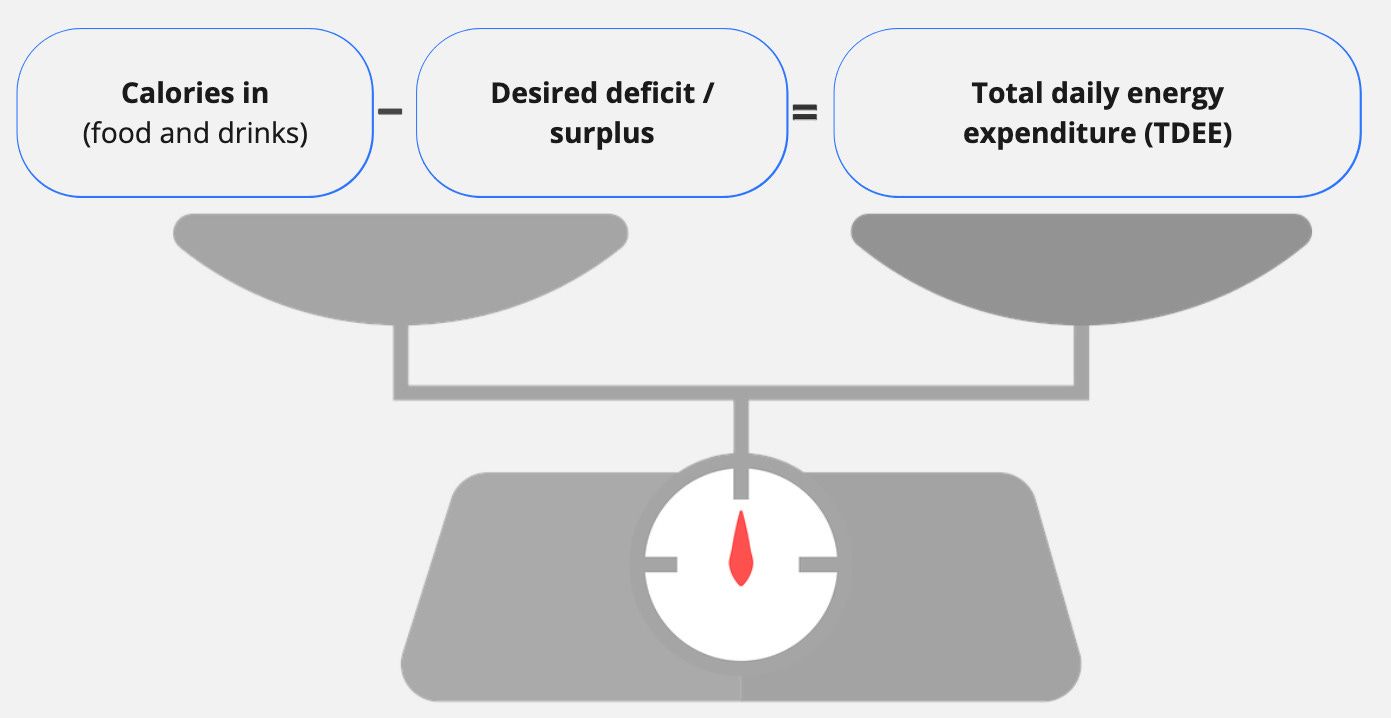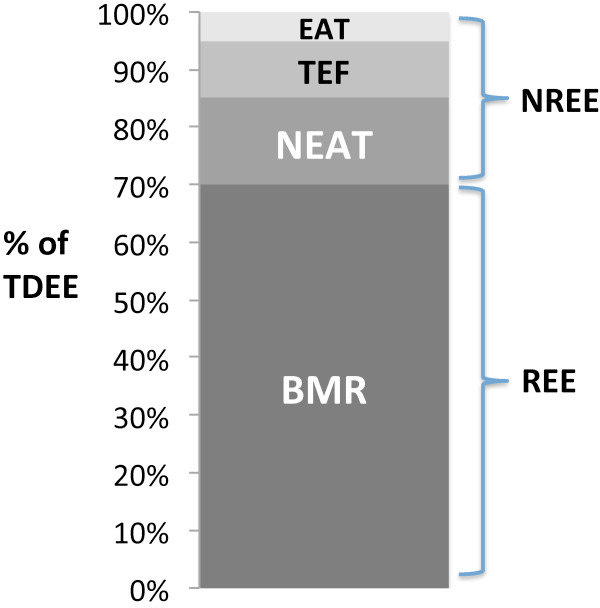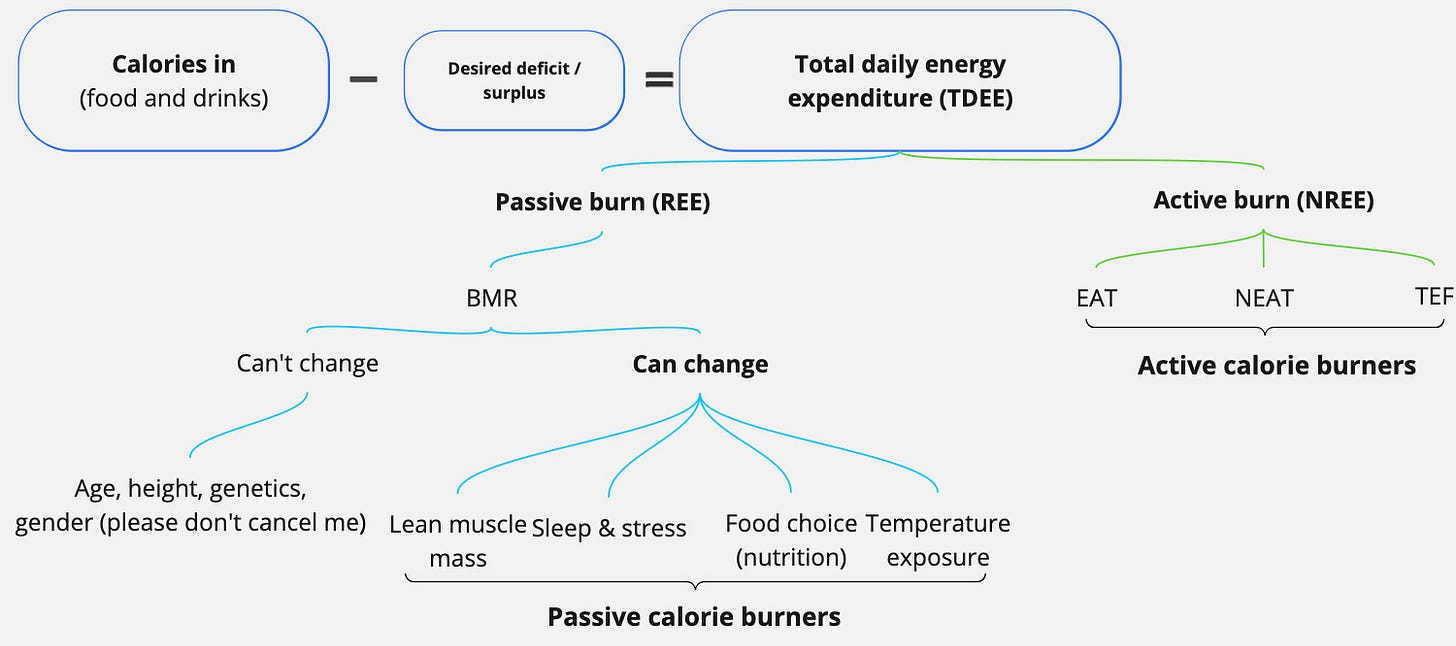How To Make Your Caloric Deficit Work For You
This is the introduction to a multi-part series, where we explore different ways to gain ascendancy over your caloric deficit (yes, I used a thesaurus)
If you’ve ever tried to lose weight, chances are you would have come across the golden equation of weight change: calories in = calories out.
Calories in represents what we eat per day.
Calories out represents what we spend as energy per day.
It’s a simple equation that follows the first law of thermodynamics, which states that energy in a closed system is neither lost or gained, only altered in form. What we consume is what we have.
Weight gain is a representation of the stored energy that comes from overconsuming. A savings account, if you will, where we deposited the excess fuel we gulped down from the all-you-can-eat barbecue last weekend.
So how do we approach weight management?
We really only have two options:
reducing our calories in, or
increasing our calories out.
Contrary to popular belief, increasing our calories out is not limited to hitting the gym and doing a lot of cardio. What if I told you there are ways to do it passively?
Before we provide an explanation for that clickbait, let’s set the stage by making sure we understand how we figure out our daily expenditure.
Google “calorie calculator”, and you’ll find a myriad of sites you can use to calculate your total daily energy expenditure (TDEE). This is, in other words, your metabolism. Here’s one that I like to use - try it out!
With your calories expended per day figured out, the math gets really simple.
Consume more calories than your TDEE, and you’ll gain weight
Consume less, and you’ll lose weight
Let’s say the TDEE we calculated is 2500 calories per day.
As long as our “calories in” is less than 2500 per day, we’ll be operating at a caloric deficit. The bigger the deficit, the faster the weight loss. 1 pound (0.45 kilograms) of body mass is approximately 3,500 calories. That means if we sustain a caloric deficit of 500 per day, we’ll have lost 1 pound by the end of the week (500 calories multiplied by 7 days).
Here’s where you might say, “But I swear I have been eating at a deficit for the past 2 weeks. I’ve been exercising too. Why isn’t the scale moving? The calculations must be wrong!”
I’m sure most of you have experienced this phenomenon where your scale refuses to cooperate. What’s really happening here?
Your calories in and out are variables that change on a daily basis, not constant numbers.
My only critique of the calories in = calories out system is its lack of awareness of variables. Variability is perhaps the most important thing to keep in mind when pursuing weight loss, and is often overlooked.
While caloric deficit is an equation that’ll always hold true whenever output is greater than input, it doesn’t take into account that we simplify calorie consumption and expenditure.
How we expend our calories depends on a few factors. These are the building blocks of our TDEE. One is our basal metabolic rate (BMR), which is calculated by inputting our height, weight, age and gender. This is the number of calories needed to keep us alive. It’s also represented as resting energy expenditure, or REE - how many calories our body passively burns while we’re at rest.
Next, you’ll want to factor in your activity level (this takes into account exercise and lifestyle), which also alters net expenditure. We quantify our activity level in two ways: exercise activity thermogenesis (EAT), and non-exercise activity thermogenesis (NEAT), which fall under the bigger category of non-resting energy expenditure (NREE).
We also require energy to digest the food we eat - thermic effect of food (TEF), which also falls under NREE. Just keep that in mind – more on this later.
In simpler terms, if you work out a lot, or your daily tasks take a lot of energy to complete, it increases the multiplier on your total energy expenditure. For example, an uptick in exercise could mean you now have to account for 1.3*TDEE. Most sites can do this step for you.
Add together our BMR and our NREE, and we end up with a constant number, which we then plan our caloric deficit around.
But things are never constant in the real world. It can never be perfect math.
Scenario 1: Our caloric intake fluctuates
Our meals often vary. We eat different things, and our caloric intake may fluctuate on a daily basis. But as long as we play within the framework of our jigsaw model (explained in one of my previous posts - check it out!), we should still end up with a net calorie loss by the end of the week.
This is where most people on a diet operate, restricting themselves to a strict meal plan that adheres to their caloric deficit.
However, note that if you’re not cooking your own meals, it’s likely that you’re underestimating how many calories you’re really consuming. When eating out, calories from oils, sauces, and drinks are impossible to estimate and are often left out of the recorded total.
Scenario 2: Our caloric output also fluctuates…?
As we mentioned, when calculating TDEE, most user-friendly equations won’t take into consideration your lifestyle choices. Fair enough - these factors are highly personal and hard to accommodate for in a general equation.
What are some factors that change how many calories we burn per day?
1. Exercise (exercise activity thermogenesis, or EAT)
The bread and butter for everyone pursuing a healthier body. Working out burns calories. The harder and longer you work out, the more calories you expend.
So when you hear others say, “oh I’ve worked out today, I have the quota for dessert”, they’re not completely wrong. Just know that 30 minutes on a treadmill only burns 200-300 calories, while a slice of cheesecake usually awards you 300-500 calories.
Unless you’re exercising for long periods of time, calories burnt from exercising usually only account for 5-10% of TDEE, and won’t tip the scales in your favor if you’re gaining it all back (or more) by eating more.
2. Lifestyle (non-exercise activity thermogenesis, or NEAT)
Do you move around a lot? Do you have to take a lot of steps to get through the day? Are you usually in charge of daily chores? NEAT takes into account everything we do that is not sleeping, eating, or sports-adjacent exercising.
Don’t sleep on these activities. They can account for up to 15% of TDEE. Think a single parent of two handling all the chores at home while working a 9 to 6. That’s a LOT of energy expended throughout the day without having to hit the gym.
“But Freeman, you promised us passive ways to increase our metabolism!”
We were just getting to that. Below are the (not-so-secret) secrets:
3. What we eat matters (the thermic effect of food, or TEF, gut health, and digestion)
“Calories are calories, bro.”
Nope. There are levels to this.
Did you know that what we eat plays a significant role in both sides of the equation? Digestion is a process that requires energy to complete, accounting for ~10% of our TDEE. Of the 3 main macronutrients, protein has the highest TEF of 25% to 30%. That means for every 100 calories of protein you consume, you have to spend 25-30% of that just to digest and absorb it.
This is significantly higher than the TEF of carbohydrates at 7-10%, and fats at 3%.
Make sure you eat your proteins!
Eating a diet that consists of a variety of mainly whole foods also plays a large role in establishing a healthy gut microbiome, which strengthens our metabolism. I won’t go into too much detail here, as gut health is a big topic that I plan to dive into in detail in the future, but just know that a diet of whole foods rich with vitamins and minerals WILL lead to better metabolism.
4. Building muscles! (Or muscle upkeep)
Going back to exercising, the reason why resistance training is so efficient for weight loss doesn’t come from the active calories burnt from the act of lifting, but the muscles that we progressively build over time.
Our muscles are high-maintenance; sustaining them requires constant fueling. As we increase our muscle mass, our resting energy expenditure for muscle upkeep slowly increases too. It’s like having multiple netflix subscriptions that keep draining us not of our money, but rather our belly fat. Sign me up!
By the way, remember proteins from the last section? Our muscles need quite a bit of protein to sustain and grow, so here we are again:
Make sure you eat your proteins!
5. Stress and sleep (double trouble)
Perhaps the most slept-on factors in weight loss (heh). Chronic stress can lower TDEE by 5-10%, while just a night of poor sleep can also lower TDEE by 5-10%. When you consider how stress and sleep often come hand in hand, you’re looking at a decrease in metabolism of up to 20%. If our TDEE was 2500 calories, that drops to 2000, which completely cancels out our caloric deficit. Ouch!
Respect your sleep, and watch your metabolism spike!
6. Environment (seasons, temperature, climate)
Do you find yourself eating more when it’s cold outside? Part of that has to do with your body requiring more energy to maintain its core temperature. This can increase TDEE by 5-15%, depending on how cold it gets.
What about heat? Hot environments also increase TDEE by 5-10%, due to the additional energy required to thermoregulate and produce sweat.
Unfortunately, most of us don’t have superpowers to manipulate the weather. Fortunately, there are methods to expose ourselves to the same effect! Saunas, steam rooms, cold showers or plunges are all great ways to kick your thermoregulation into overdrive, driving up metabolism.
Takeaways
Here’s a diagram to demonstrate how our TDEE works:
These are some of the factors you can use to increase your TDEE:
Exercise
Lifestyle
Food choice (proteins!)
Temperature
…And these are the factors that can decrease your TDEE (look out!)
Stress
Poor sleep
Poor food choice (processed foods, alcohol etc.)
Each factor plays a small role in your daily total. You might have a 2,500-calorie TDEE to work off of, but know that the number fluctuates and changes on a daily basis.
By taking advantage of what we now know, we can pick and choose our battles with calorie budgeting. I plan to get to bed before 12, and take a cold shower every morning.
They might not amount to much alone, but a little here and a little there and BOOM, you could have yourself an extra 500 calories to work with. That could be your entire deficit!
Ultimately, every weight loss journey will only succeed under a caloric deficit. However, don’t feel tied down to following a restrictive diet to achieve this. Personalize your approach to your caloric deficit based on this list of factors. In fact, grab a pen and jot down a few things you think you can put to action right away. Play around with what feels easier for you to maintain.
Gaining muscles isn’t a necessity in weight loss, but it definitely makes it much easier to sustain. Once we find a routine we can keep up, results will surely follow.
Don’t be discouraged by short term weight fluctuations either. You now know that our daily energy needs also fluctuate based on how we fuel, exercise, and rest.
So give it a go - start simple, and progress. You got this!
That being said, if you're feeling the love and would like to make a kind donation to fuel my rather large amount of caffeine intake, you can buy me a coffee here.
My content here is free, so a donation of any amount would mean the world to me as it gives me the confidence that what I’m doing is making a difference!






